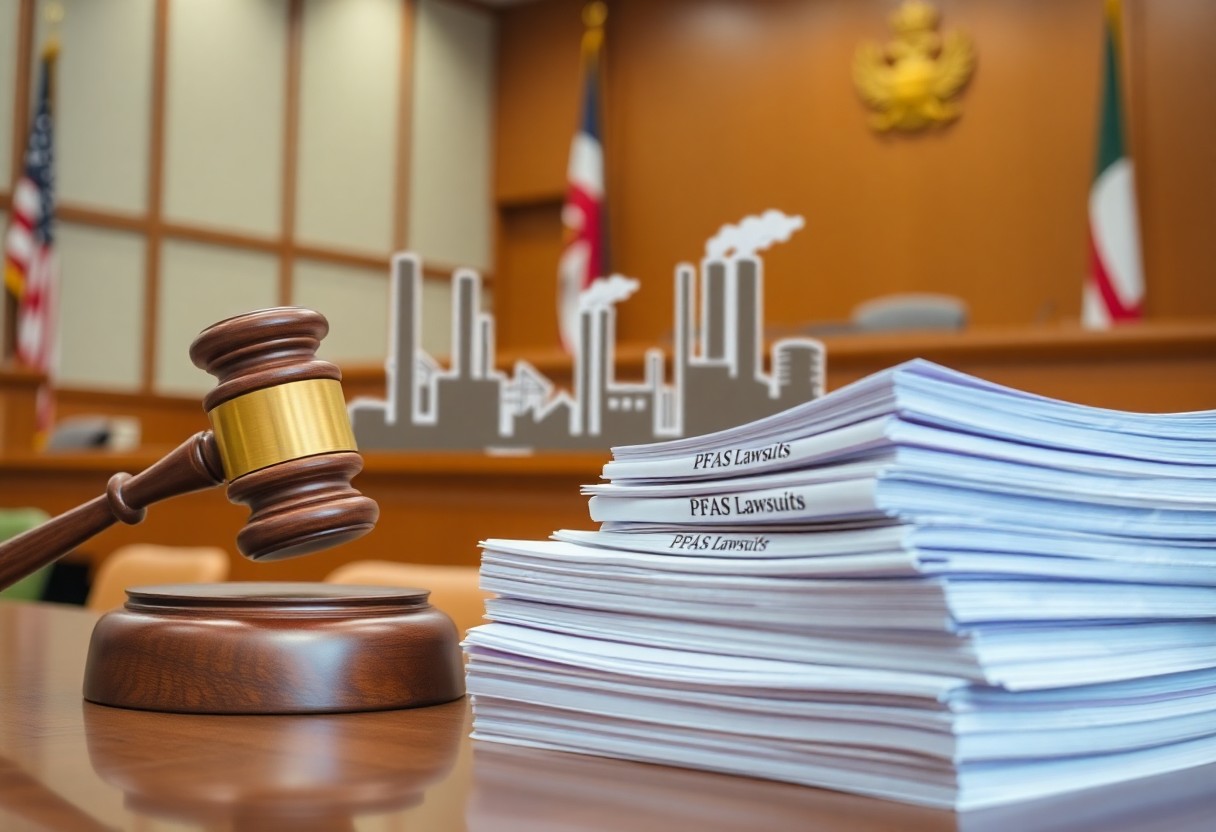Over the past few years, the alarming rise of PFAS chemicals in our environment has sparked numerous soil contamination lawsuits across the nation. These persistent pollutants pose serious health risks, affecting water supplies and agricultural land near your home. If you live in an area where these substances have been detected, it’s important to understand the implications, your rights, and the legal avenues available to you. This blog post will guide you through the vitals of soil contamination lawsuits related to PFAS, helping you protect your family and your property.

Understanding PFAS
For many homeowners, the presence of PFAS (per- and polyfluoroalkyl substances) in your environment can raise significant health concerns. These man-made chemicals are widely known for their resistance to water and heat, making them useful in various consumer products. However, their persistence in the environment coupled with potential health risks makes understanding PFAS vital for any homeowner worried about soil contamination and your family’s health.
What are PFAS?
Behind the science of PFAS lies a complex group of synthetic chemicals that have been used since the 1950s in various applications, such as firefighting foam, non-stick cookware, and water-repellent fabrics. Their chemical structure provides stability, which results in persistent environmental contamination that can accumulate in soil and groundwater, posing significant risks to human health and ecosystems.
Sources of PFAS Contamination
On a broader scale, PFAS contamination often originates from industrial sites, landfills, and military bases where firefighting foam has been used. You might also encounter PFAS in everyday products such as fast-food packaging, stain-resistant carpets, and waterproof clothing. Many communities are discovering that these substances can seep into your local water supply, leading to heightened public health concerns.
A deeper examination reveals that industrial discharges and improper disposal methods are common pathways for PFAS entering the environment. The use of firefighting foams at airports and military training sites has been a major source of groundwater contamination. Certain towns may also experience PFAS infiltration from landfills or wastewater treatment plants that process contaminated materials. It’s vital for you to be aware of these sources, as they can directly affect your water quality and soil health, presenting potential risks to your family’s well-being.
Health Risks Associated with PFAS
Assuming you live near a site contaminated with PFAS, you should be aware of potential health risks. These substances, often called “forever chemicals,” can accumulate in your body over time, leading to a variety of health concerns. Studies suggest that PFAS exposure is linked to serious conditions, including weakened immune response, increased cholesterol levels, and even some cancers. Understanding these risks is crucial for protecting yourself and your family.
Short-term Effects
At high levels of exposure, you may experience short-term effects such as skin irritation, rashes, and changes in liver function. While these symptoms can be concerning, they are often reversible upon reducing or eliminating exposure to PFAS.
Long-term Impacts
For those exposed to PFAS over an extended period, the consequences can be more severe, affecting your overall health significantly.
With long-term exposure to PFAS, you increase your risk of developing chronic health conditions such as kidney cancer, testicular cancer, and other serious diseases. These chemicals can disrupt your endocrine system, leading to reproductive issues and possibly affecting child development as well. Furthermore, PFAS can accumulate in your body, resulting in persistent health issues or complications even after exposure has ceased. Taking steps to minimize this exposure can help safeguard your long-term well-being.
Legal Landscape of Soil Contamination
Any understanding of soil contamination laws is imperative for you as a community member concerned about the safety of your environment. These laws aim to protect public health and provide a framework for addressing polluted sites, holding responsible parties accountable, and guiding remediation efforts. You’ll find a mix of federal, state, and local regulations that govern contaminated land, demonstrating the complexity of the legal landscape in addressing soil issues.
Existing Laws and Regulations
Soil contamination is primarily regulated through various federal laws such as the Comprehensive Environmental Response, Compensation, and Liability Act (CERCLA) and the Resource Conservation and Recovery Act (RCRA). State regulations may vary, but they typically align with federal standards to manage the remediation of hazardous waste and ensure public safety. As you navigate through these regulations, it’s imperative to understand your rights and responsibilities concerning contaminated properties.
Notable Case Studies
Across the U.S., various case studies illustrate the impact of soil contamination and the legal ramifications involved. These notorious situations showcase the importance of government action and community involvement in addressing PFAS and other contaminants.
- West Virginia, 2014: A chemical spill contaminated drinking water for over 300,000 residents, leading to lawsuits amounting to $151 million.
- New Jersey, 2018: A major site was found contaminated with PFAS, resulting in over $40 million dedicated to cleanup efforts and local health assessments.
- Michigan, 2020: PFAS contamination in military sites led to a settlement of $69 million for affected residents.
- California, 2021: A lawsuit regarding carcinogenic compounds resulted in a $1.3 billion settlement for future health monitoring and remediation.
In addition, these case studies highlight how legal action can lead to significant changes in policy and remediation processes. For instance, West Virginia’s chemical spill prompted new regulations on chemical storage, while Michigan’s case fostered a push for more stringent PFAS standards statewide. Your engagement in community awareness initiatives could support ongoing efforts to hold polluters accountable and protect your public health.
Navigating Soil Contamination Lawsuits
Now that you’re aware of the implications of PFAS contamination in your backyard, navigating soil contamination lawsuits can be daunting. It’s important to understand your rights and the legal process involved. With proper guidance, you can effectively advocate for your health and property, holding responsible parties accountable for their actions and seeking justice.
Steps to Take
Steps to take when dealing with soil contamination include conducting thorough research into the sources of contamination, documenting any evidence, and reaching out to neighbors who may be affected as well. Collecting soil samples for testing can be a significant first step toward establishing a case. Additionally, familiarize yourself with state and local regulations regarding environmental contamination to better understand your position.
Finding Legal Representation
Legal assistance is vital when pursuing a soil contamination lawsuit. You should seek an attorney with experience in environmental law and a solid track record in handling similar cases.
In fact, partnering with a knowledgeable attorney can make a significant difference in the outcome of your case. Look for someone who specializes in PFAS-related environmental issues, as they will be familiar with the complexities of soil contamination claims. An experienced lawyer can help you build a compelling case by gathering vital evidence, navigating legal procedures, and maximizing your potential compensation for health impacts and property damage. Don’t underestimate the importance of having strong legal representation on your side throughout this challenging process.
The Role of Environmental Agencies
Many individuals may not realize the profound impact environmental agencies have on addressing PFAS contamination in soil. These agencies serve as critical watchdogs, implementing regulations and monitoring the presence of harmful substances. They also collaborate with local communities to ensure safe environmental practices while enforcing laws that protect public health and natural resources from contamination.
Regulatory Framework
Agencies create a regulatory framework that dictates how pollutants, such as PFAS, are monitored and managed. This framework includes guidelines for testing soil and water, establishing acceptable limits for contaminants, and ensuring that industries comply with environmental safety standards. Such regulations are vital in empowering you to hold polluters accountable.
Community Resources
Around your community, resources exist to assist you in understanding and addressing PFAS issues. Local environmental agencies often provide information on soil testing and contamination levels, as well as guidance on safety measures you can take. They also facilitate workshops and forums to educate residents about potential health impacts and response strategies.
It is important for you to leverage community resources that can provide support in dealing with PFAS contamination. By accessing information through local agencies and community organizations, you can find testing services, advocacy groups, and educational materials that outline the risks associated with PFAS. Networking with others in your area who are facing similar challenges can also yield valuable insights and create a stronger voice for your community as you work together toward environmental justice and health protection.
Preventive Measures and Solutions
Your vigilance and proactive approach are necessary in preventing soil contamination from PFAS. By implementing effective strategies such as community awareness programs and proper disposal methods, you can significantly reduce the risk of exposure to these harmful chemicals. Additionally, partnering with local organizations and environmental agencies can help promote cleaner practices and protect your backyard from potential pollution.
Soil Testing and Remediation
One of the most effective ways to ensure the safety of your land is through regular soil testing. By detecting PFAS and other contaminants early, you can take appropriate remediation measures to restore your soil to its natural state, safeguarding both your family and the environment.
Community Advocacy
Between individuals and groups coming together, community advocacy plays a vital role in addressing soil contamination issues. Engaging in local meetings and initiatives can help raise awareness about PFAS risks and push for necessary policy changes. Your voice matters, and by participating, you contribute to a collective effort to protect your neighborhood.
In addition, community advocacy empowers residents to demand accountability from industries responsible for pollution and encourages local government action to enforce stricter regulations. By mobilizing your neighbors and collaborating with environmental organizations, you can create a stronger impact in striving for cleaner soil and safer environments. Your involvement not only benefits your backyard but also promotes a healthier community for everyone.
To wrap up
From above, it’s evident that soil contamination from PFAS poses significant risks to public health and the environment. As a property owner or resident, you must be proactive in understanding the implications of these contaminants in your backyard. Engaging in soil contamination lawsuits can serve as a vital mechanism to hold responsible parties accountable and seek justice for your community. By staying informed and advocating for clean soil, you play an important role in protecting your health and ensuring a safer environment for future generations.



















